This is the second part of a lesson which started here. Last time, we looked at approaching unseen poetry questions and we concentrated on that idea of taking three bunny hops (just like the Love-Not-Money Bunny) between key words and really analysing those seemingly tiny but very important connections in careful and original detail. Today, we’re looking at the different types of rhyme you might spot and what to do with that rhyme when you do spot it!
First, try matching the type of rhyme (highlighted in yellow) with the relevant poem (okay, we know they’re song lyrics, but we’re calling them poems!). If you need to look up the meaning of the different rhyme types, you can do that.



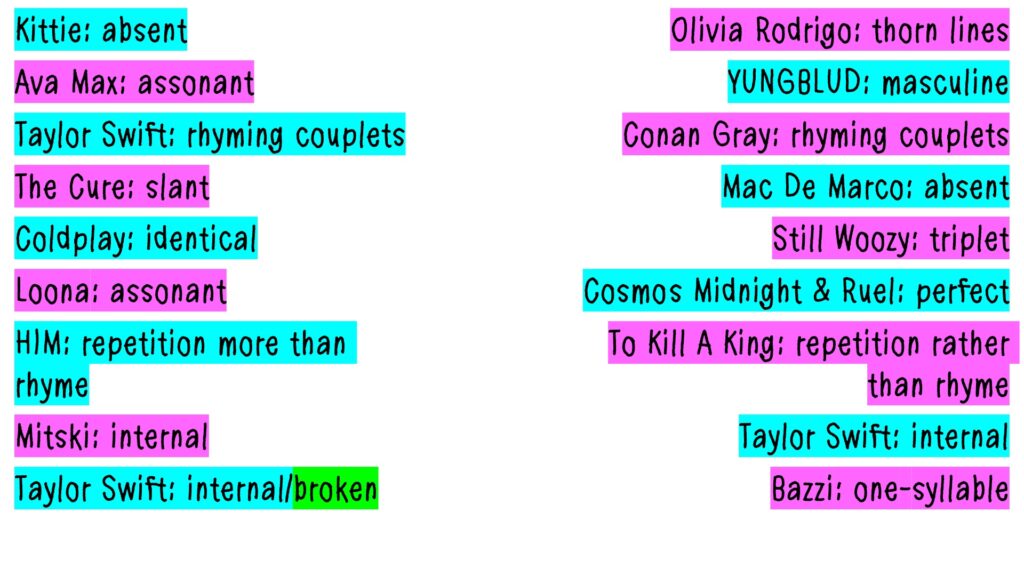
Okay, your job now is to write a paragraph comparing two of the poems on this list. I have paired them up below and each pair comes with its own question. Your paragraph needs to consist of analysis of a word or phrase from each poem (make sure to really cement the link between the two words/phrases you’ve chosen) and analysis of the rhyme. You need to analyse the rhyme in a way that fits with the point you’re already making. Have a look at the paragraph below for an example. It starts with that close analysis of the language used by Ava Max and Kittie, then links to the use of rhyme:
Compare and contrast the significance of female oppression in ‘Spit’ and ‘Kings and Queens’.
The contrast between the poets’ attitudes towards the men responsible for female oppression and the women who have suffered that oppression is marked. These men lurk in the ‘shadows’ – once again highlighting the oppression they have enforced upon women as a product of darkness and evil. Forces for good don’t typically live in the shadows, they are out in the light, sitting up on Ava Max’s ‘thrones’. The absence of rhyme within ‘Spit’ really illustrates Kittie’s contempt for those responsible for female oppression. On one hand, it represents Kittie’s extreme anger. Their emotions are raging so of course there is no regular rhyme scheme; the way the world works is beyond reason and to try to suggest that anything rhymes – that anything ‘fits’ – would be ridiculous. Ava Max’s assonant rhyme feels just as purposeful, though. It’s as if she can see the potential for a world that ‘fits’. There’s a rhyme hidden in there somewhere. It’s not perfect yet, but we’re closer in 2020 (when ‘Kings and Queens’ was written) than we were in 2000 (when ‘Spit’ was written). That assonant sound feels too like a cry from the darkness, a woman shouting from those shadows the men have tried to drape them in. The more women that shout – and the more of us that hear and understand what the shouts mean – the closer we’ll be to ending the female oppression that both of these poems want to consign to the past.
Right, your turn! Pick the pair of poems you want to study, then have a go at writing a paragraph. If you don’t know the songs, you can find the relevant sections here.
PAIR 1:
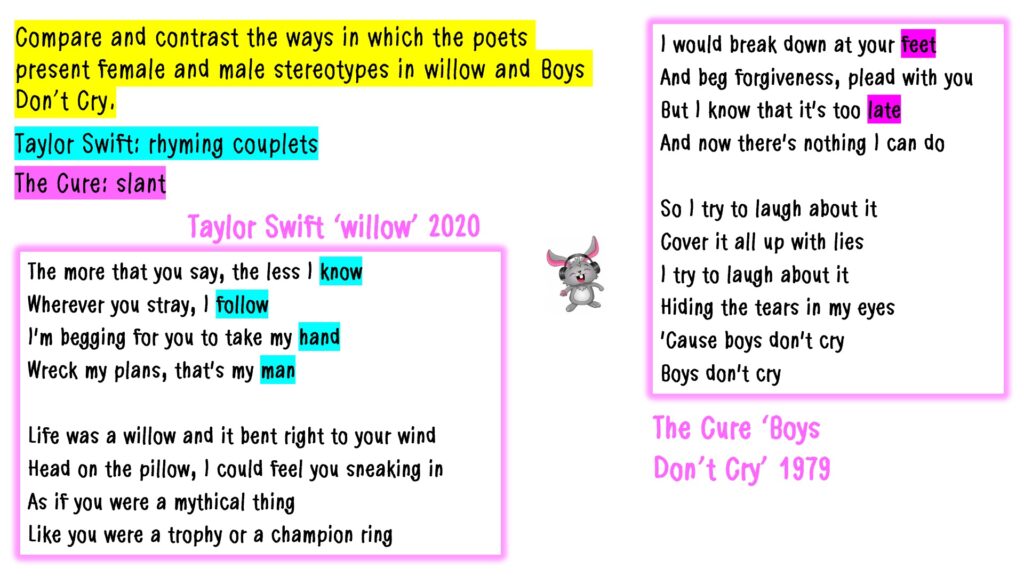
PAIR 2:
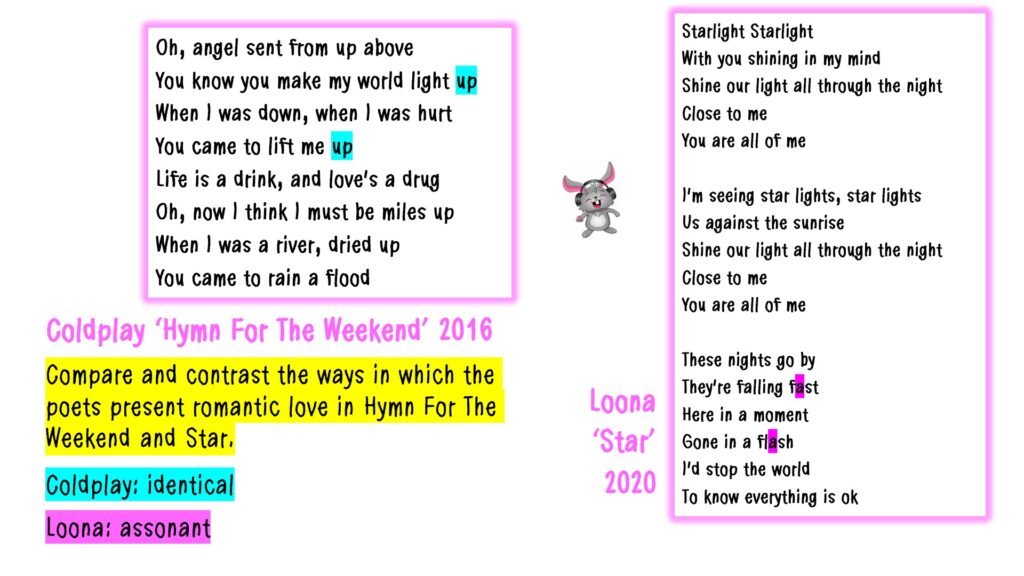
PAIR 3:
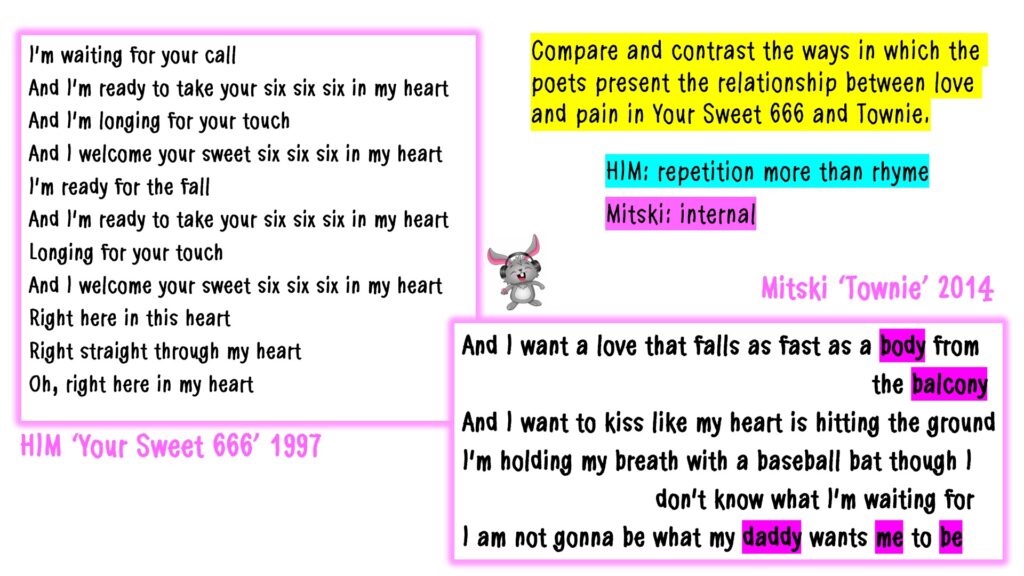
PAIR 4:
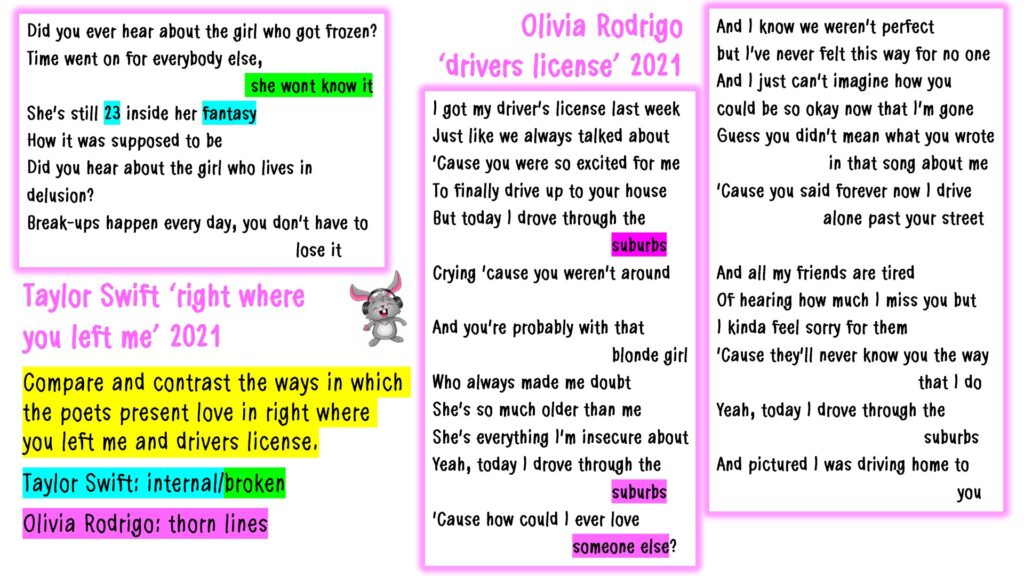
PAIR 5:
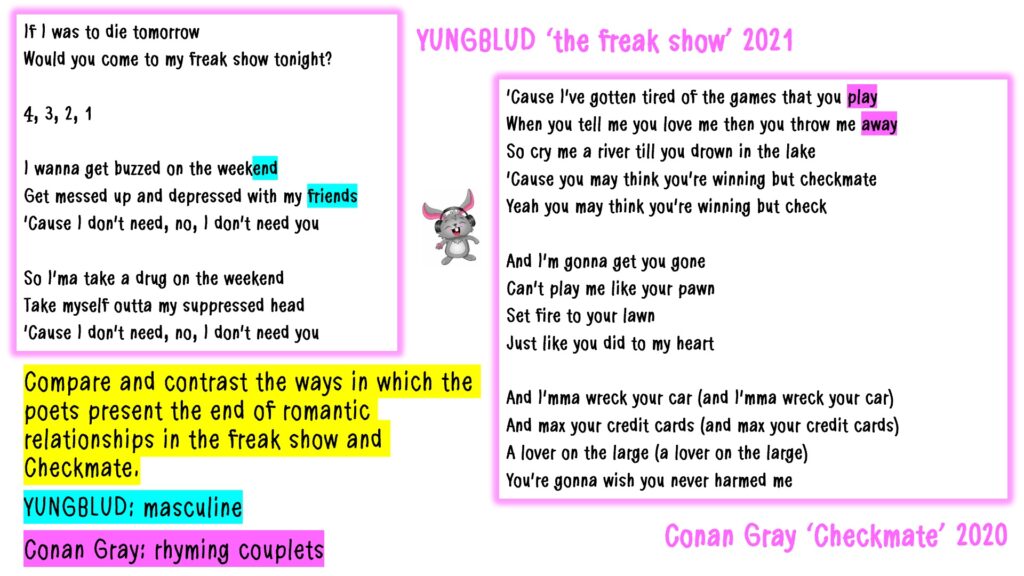
PAIR 6:
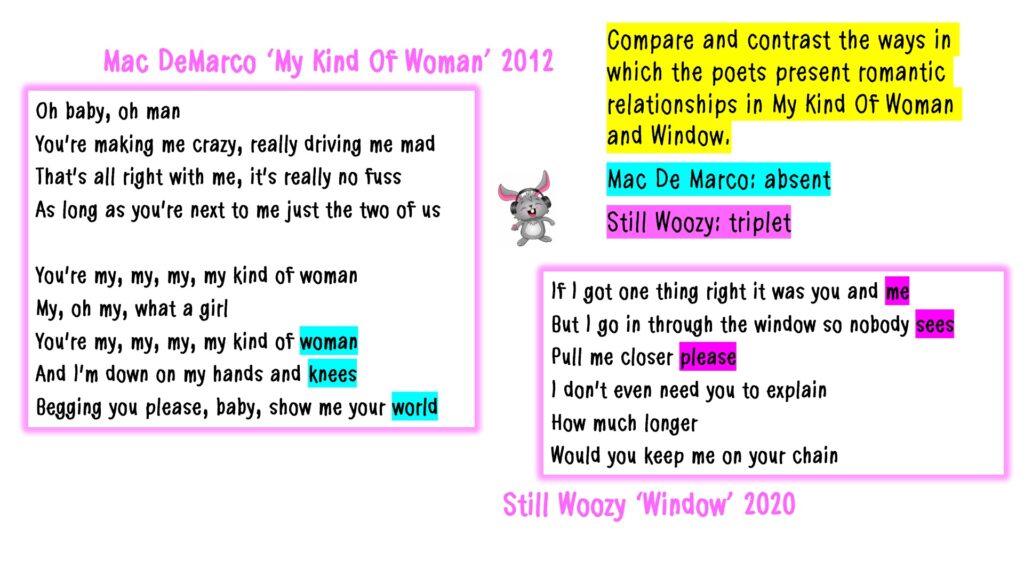
PAIR 7:
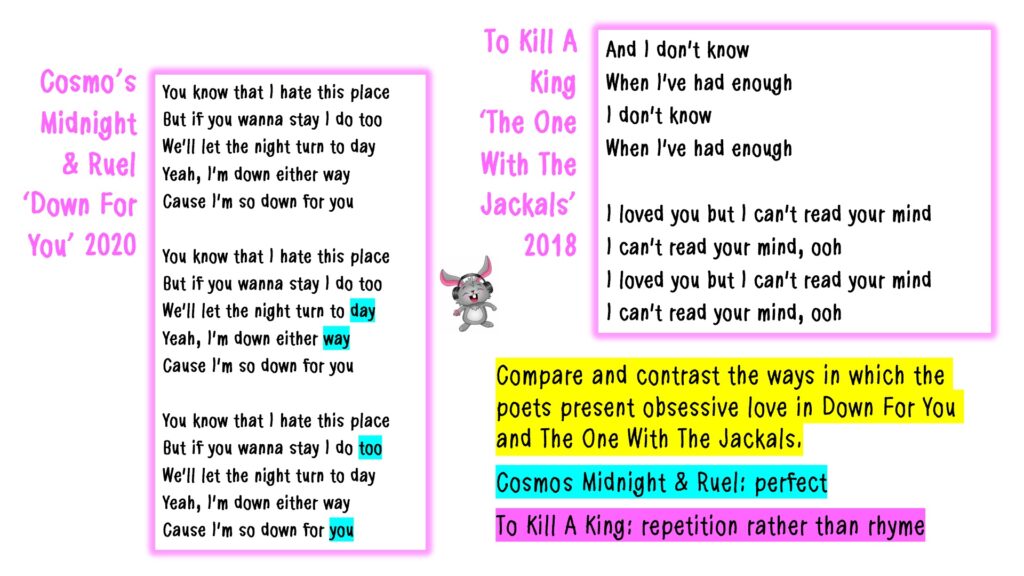
PAIR 8:

Please do send us your work! We would love to feedback or publish.
Read below to see what the incredibly talented Daisy wrote. In class, in timed conditions! Proper mastery of the unseen poetry skills! Amazing!
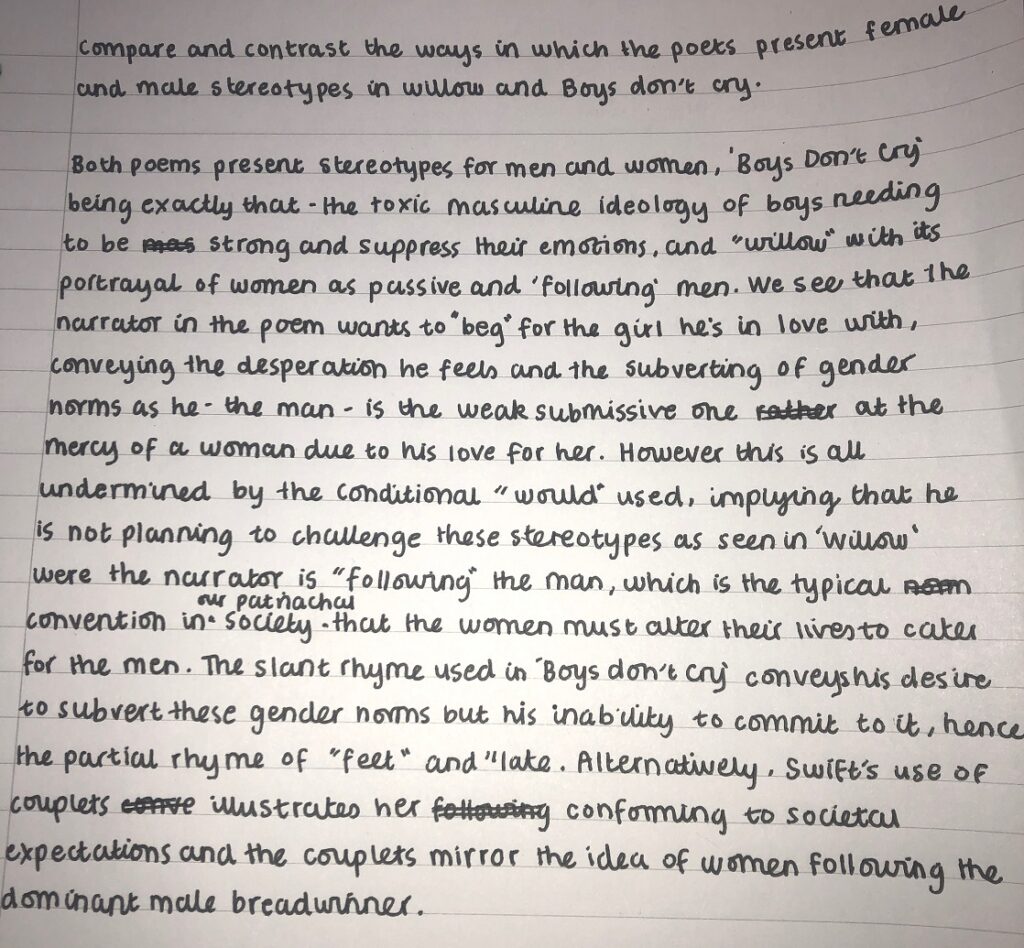
And just to stun you even more completely, here’s a paragraph from Izzi. Also in timed conditions. I KNOW!!!!! Amaaaaaaaazing!
There is a stark similarity between the two poems in that they are both exploring ideas of desiring your significant other. However the contrast is within the method of doing so. In Mac DeMarco’s ‘My Kind of Woman’, the love is evidently unrequited and there does appear to be an impasse between him and his lover. He demonstrates this through his use of the continuous verb ‘begging’, which not only is connoted with immense desire and yearning, but also the continuous nature of the verb suggests that this feeling is ongoing. Furthermore, DeMarco’s use of absent rhyme throughout highlights the lack of amorous reciprocation between the pair, as there is a sense of absence – isolation – that he feels. Perhaps DeMarco is trying to suggest that no matter the extent at which you want a romantic relationship with somebody, it is very difficult or impossible to achieve it with your ‘Kind of Woman’, the person you desire most. The verb ‘begging’ has a clear link to ‘Window’ where Still Woozy uses the adverb ‘please’ to express the extent of his desire for his lover; pleading is absolutely a synonym of ‘begging’. This undoubtedly links the two and implies a sense of absence in both as previously discussed, however our distinction lies in the requited nature of Still Woozy’s poem. This is made evident through his claim that the ‘one thing right [that he got] was you and me’ meaning that, unlike DeMarco’s poem, the relationship is mutual, however there continues to be an impasse between them, which could be argued is the need to social distance from loved ones as this poem was written amidst the Covid-19 pandemic. Triplet rhyming is often also used to highlight a climax in emotions, and Still Woozy seamlessly uses this technique in his chorus: ‘me’, ‘sees’ and ‘please’. Through this extent of rhyming words, he highlights the intensity of his love and yearning for his significant other, which contrasts to DeMarco’s poem as he focuses on the absence of a loved one in his rhyme whereas Still Woozy focuses on the extent of his love in his.
Huge thanks to Daisy and Izzi – such talented writers and such incredible readers of human emotion and intent!!
If you’re studying for A-Level exams, Taylor Swift can help you with your unseen poetry!
If you’re studying for GCSE exams, Against The Current can help you with your unseen poetry!
Thanks to Olivia Rodrigo, Bazzi and all the other brilliant artists who inspired this lesson!!

